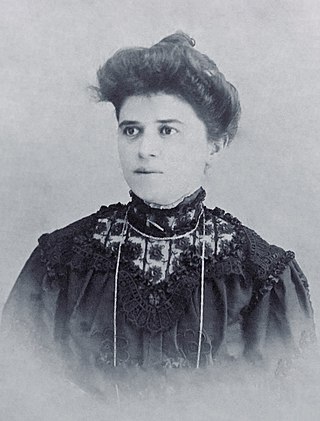Related Research Articles

Pandeli Sotiri (1842–1892) was an Albanian activist that acted as director of the first Albanian school of modern times in Korçë. Sotiri was one of the most important Rilindas figures that contributed in the propagation of the Albanian language. He also worked on one of the versions of the Albanian alphabet. The Congress of Monastir based Albanian's alphabet mostly on Sotiri's precedent work.

Parashqevi Qiriazi was an Albanian teacher of the Qiriazi family who dedicated her life to the Albanian alphabet and to the instruction of written Albanian language. She was a woman participant at the Congress of Manastir, which decided the form of the Albanian alphabet, and the founder of the Yll' i Mengjesit, a women's association. Parashqevi was also a participant in the Paris Peace Conference, 1919 as a member of the Albanian-American community. She was the sister of Sevasti Qiriazi, who was the director of the first Albanian School for girls in Korça, opened in 1891.

Abdurrauf Fico (1881–1944), also known as Rauf Fitso Bey was an Albanian ambassador and politician.
Holy Trinity Church of Lavdar, also known as the Holy Trinity Church of Tudas is a 15th century Albanian orthodox church built in the Byzantine style by the medieval Albanian noble family of Muzaka. It is located near the villages Lavdar and Tudas in the region of Opar in Korçë county, southeastern Albania. Noted for its distinguished architecture and frescoes, it was declared a Cultural Monument of Albania in 1963.

The Committee for the National Defence of Kosovo was an Albanian organization founded in Shkodër on 1 May 1918. It was mainly consisted of the political exiles from Kosovo and was led by Hoxha Kadri from Pristina. It existed in looser form since May 1915.
The House of Taushani was an Albanian aristocratic family prominent from the 15th to 19th century. According to prof. Stavri Naci, the most powerful families of Albania that played an important economic and political role were, "in Shkoder, the Bushati and Caushollaj; in Peja, Begollaj; in Elbasan, Taushani and Bicaku; in Vlora, Velabishtaj and Vlora; in Delvina, Kapllanpashalli; in Kruja, Toptani; and in Kavaja, the Alltuni."
Irreligion, atheism and agnosticism are present among Albanians, along with the predominant faiths of Islam and Christianity. The majority of Albanians lead a secular life and reject religious considerations to shape or condition their way of life.

Sevasti Qiriazi-Dako was an Albanian patriot, educator, Protestant missionary, author, pioneer of Albanian female education, and activist of the Albanian National Awakening.

Metropolitan Visarion Xhuvani was the primate of the Orthodox Autocephalous Church of Albania from 1929 to 1936. He was a main contributor to the autocephaly, and a close collaborator of Fan Noli.

Skënder Petro Luarasi was an Albanian scholar, writer and anti-fascist activist.

Hysni Curri (?–1925) was a Kosovar Albanian military figure and a prominent leader of the Kachak movement and the Committee for the National Defence of Kosovo.

Aqif Pasha Biçaku mostly known as Aqif Pashë Elbasani was an Ottoman Albanian political figure in the Sanjak of Elbasan and after the Young Turk Revolution became an activist for the Albanian national cause.
Constantine of Berat, known among Albanians as Kostandin Jermonak Berati or shortly Kostë Berati, was an Albanian writer and translator of the 18th century.

Erion Veliaj is an Albanian, politician, who is currently serving as the Mayor of Tirana. Stemming from a civil society activism organization as the leader of MJAFT!, Veliaj joined the ranks of the Socialist Party of Albania in 2011, when he was appointed Secretary for Youth and Immigration.
The Second Congress of Manastir was an Albanian congress held on 2–3 April 1910 in Manastir, back then Ottoman Empire, today's Bitola in the Republic of North Macedonia. It dealt with the challenges that the Albanian language and schools faced at the time within the context of the empire, and the platform to overcome them.

The Old Mosque or Sulejman Pasha mosque was the founding mosque of the Albanian capital Tirana. The city developed around the mosque, which was founded by the Ottoman Albanian Pasha Sulejman Bargjini along with a hammam and a bakery. In the mid of the 20th century, all of it was razed to make place for the Communist-era Unknown Soldier statue.

The St. Anthony Church(Albanian: Kisha e Shna Ndout or Kisha e Laçit), is a church first built in 1300, then destroyed in 1971, and eventually rebuilt in the 1990s in the Albanian town of Laç.
Gilman Bakalli was an Albanian professor, politician, writer and a member of parliament from 2005 to 2009.
Athanas Shundi was an Albanian patriot and an important member of the autocephalist movement of the Albanian Orthodox Church. In his last years of life he was also involved in politics, as a member of the Tirana's city council, as well as a member of the Constituent Assembly of Albania during the legislature of 12 April 1939 - 1 April 1940.
References
- ↑ Ruches, Pyrrhus J., Albanian historical folksongs, 1716–1943: a survey of oral epic poetry from southern Albania, with original texts (1967), Argonaut
- 1 2 3 Shkreli, Artan (4 May 2012). "Kisha e Shen Prokopit". Gazeta Shqip.
...aty nga viti 1787 bargjinollët mirënjohës ndaj ndihmës së ortodoksëve në mbrojtjen e Tiranës nga Kurt Pasha i Beratit, lejuan ndërtimin e kishës kushtuar shenjtit Prokop.
Ndërtimi më 1874 i kishës së Evangjelizmosë brenda në Tiranë (aty ku sot është Hotel Tirana) shenjoi të ardhmen e Kishës së vjetër të Shën Prokopit. Fluksi i besimtarëve ra pasi tani përballohej nga kisha e re dhe qetësia që pllakosi mbi Shën Prokopin thyhej vetëm të kremtet e mëdha dhe në ditën e shënuar të pajtorit, më 8 korrik. - ↑ Beduli 1997
- ↑ "Veliaj: Kisha e Shën Prokopit dhe Liqeni do të kthehen në identitet". Gazeta Shqip. 19 December 2017. Retrieved 25 September 2020.